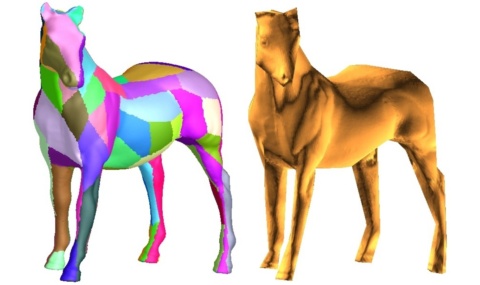Texture mapping progressive meshes

ACM SIGGRAPH 2001 Proceedings, 409-416.
Texture atlas compatible across levels of detail, and parameterization stretch.
Abstract:
Given an arbitrary mesh, we present a method to construct a progressive mesh (PM) such that all meshes in
the PM sequence share a common texture parametrization. Our method considers two important goals
simultaneously. It minimizes texture stretch (small texture distances mapped onto large surface distances)
to balance sampling rates over all locations and directions on the surface. It also minimizes texture
deviation ("slippage" error based on parametric correspondence) to obtain accurate textured mesh
approximations. The method begins by partitioning the mesh into charts using planarity and compactness
heuristics. It creates a stretch-minimizing parametrization within each chart, and resizes the charts
based on the resulting stretch. Next, it simplifies the mesh while respecting the chart boundaries. The
parametrization is re-optimized to reduce both stretch and deviation over the whole PM sequence. Finally,
the charts are packed into a texture atlas. We demonstrate using such atlases to sample color and normal
maps over several models.
Hindsights:
The geometric-stretch parametrization introduced in this paper is a nice principled contribution,
and should have been given stronger emphasis.
Signal-specialized parametrization (2002)
presents a hierarchical algorithm to efficiently compute this parametrization on large patches, and shows
that the chart boundary need not be fixed but can be optimized as well.
The irregular "cruft" present in several of the parametrizations is addressed by the inverse-stretch
regularization term described in the 2003
Spherical Parametrization paper.
Many of our ideas (signal-specialization, integrated metric tensor, atlas packing, etc.) have been adapted in the UVAtlas technology of the Microsoft Direct3D SDK.
See content copyrights.